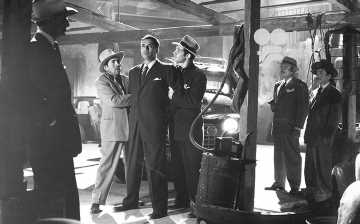The 76th Locarno Film Festival is hosting one of the largest international retrospectives of Mexican popular cinema in decades, encompassing 36 titles of varying genres, from dramas to film noir as well as comedies, musicals, horror and sports.
Putting together “Daily Spectacle – The Different Seasons of Mexican Popular Cinema” took at least two years, according to writer and programmer Olaf Möller, who curated the selection alongside critic Roberto Turigliatto and in close collaboration with Filmoteca UNAM director Hugo Villa and other key experts.
The unprecedented showcase of Mexican films ranging from the 1940s to the 1960s spans some 30 years of extraordinary creativity, which inspired subsequent generations of Mexican filmmakers.
Locarno first hosted a retrospective of Mexican cinema in 1957 but this new showcase goes beyond the Golden Age to more popular titles, with the oldest being “En Tiempos de Don Porfirio” (1940) and the youngest among them “Olimpiada en México”(1969), “two films that in their own way are dealing with questions of dictatorship, of covering up dictatorships and of certain tensions between stories that get most told and reflections in the stories that do get told,” said Möller, who also wanted to include Miguel Delgado’s wildly popular “The Three Musketeers” but could not find a decent print.
The films were gathered from various collections, mostly from the Filmoteca UNAM, and in collaboration with the Mexican Institute of Cinematography (Imcine), the National Film Archive, the Morelia International Film Festival, Churubusco Studios and Permanencia Voluntaria.
According to Villa, finding available titles that were in optimum condition, securing the rights and getting them sub-titled was a painstaking process.
While some titles are digitized, others were restored to their original format, a highly meticulous procedure.
UNAM’s highly skilled restoration technicians restore only about two to three titles a year, a slow and demanding procedure that sees them working frame-by-frame, sometimes with Q-tips, said Villa.
The festival kicks off with a sports-themed day, noted Möller, who’s a sports fanatic himself, with “Olimpiada en Mexico,” “La Noche Avanza,” “El Gran Campeon” and “Torero” on the first day.

Docu “Olimpiada en Mexico“ (“Olympics in Mexico”) by Alberto Isaac chronicles the first Olympic Games held in a Latin American and Spanish-speaking country.
“El Gran Campeon” (“The Great Champion”)(1949), follows the rise of boxer Kid Azteca, who was the welterweight champion in Mexico from 1932 to 1948.
Lauded film noir “La noche avanza” (“The Night Advances”) (1952) by Roberto Gavaldón, turns on Jai-alai player Marcos, a serial womanizer whose luck with women starts to wane as gangsters close in on him.
“Torero” (Bullfighter”) (1957) by Carlos Velo, started the Filmoteca UNAM collection in 1960, which now has some 45,000 titles in its vaults, said Villa.
Other notable titles include “El Suavecito” (1951) by Fernando Méndez, digitally restored in 2019 with the support of the University of Guadalajara, the Guadalajara Film Festival, Fundación Televisa and Oscar-winning filmmaker Guillermo del Toro.
“El Esqueleto de la Sra. Morales” (“The Skeleton of Mrs. Morales”) (1959) by Rogelio A. González is “probably the best Buñuel movie not made by Buñuel,” said Möller. For film scholars, the surreal dark comedy about a taxidermist who is driven to the brink by his manipulative, bigoted wife, marked the transition from the Golden Age to auteur cinema.

Two other films by Gavaldón, “They Have Killed Tongolele” (1948) and “Autumn Days” (1963) will also screen. “36 titles isn’t enough to show every major film by Gavaldón, one of the most prolific filmmakers in Mexican cinema,” Möller noted.
“These crazy cult movies were often by the same people who made very respectable classics,” he asserted noting that Mexican cinema during that period, was “extremely cosmopolitan” adding that “there were so many directors from other countries working there. Mexico was really a hub at that point in time for Spanish speaking filmmakers.”
This massive collaboration was also made possible by Fundación Televisa, Claro Video, Carlos Vasallo, TV Azteca, Olympusat, Park Circus, Le Films du Camelia, the filmmaker Marcela Fernández Violante and Viviana García Besné.
In addition, the archives, production companies, and distributors that collaborated to integrate this retrospective include: Filmex, Alameda Films, 3-D Film Archive, Matilde Landeta Cultural Association A.C., Nuevo Cinema Latino, the International Olympic Committee, Athos Overseas Limited Corp, Mario Moreno Foundation, Calderón Cinematographic, Sony Pictures, STPC – Cinematographic Production Workers Union of the Mexican Republic – and STYM – Technical and Manual Production Workers Union of the Mexican Republic.
The 76th Locarno Film Festival runs Aug. 2-12.
Read More About:
Source: Read Full Article



